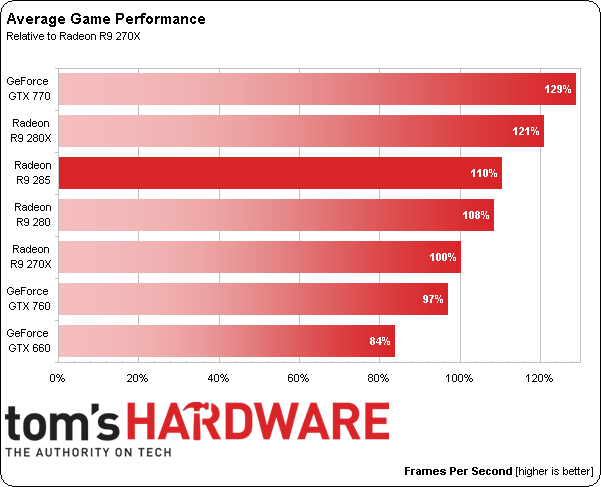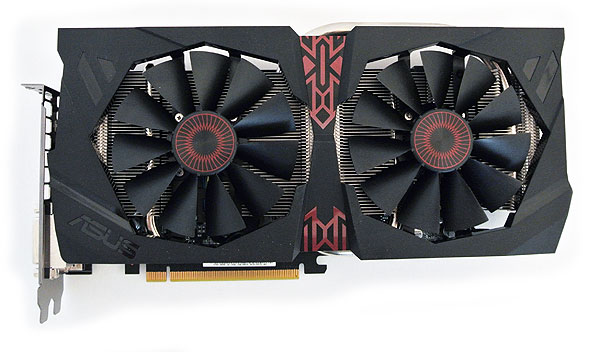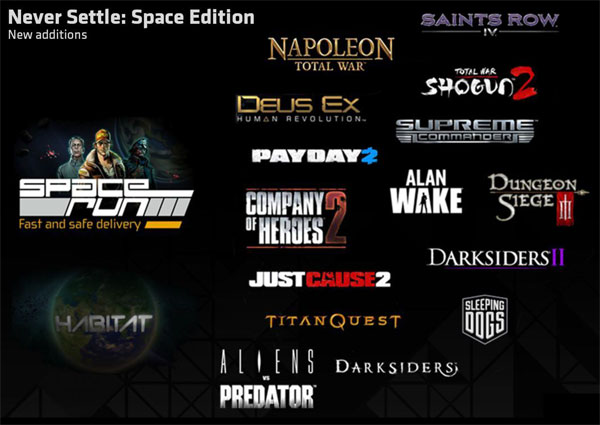AMD Radeon R9 285 Review: Tonga and GCN Update 3.0
On paper, the new Tonga-based R9 285 looks to be slightly slower than the R9 280 it is intended to replace, but there's more than meets the eye.
Why you can trust Tom's Hardware
Radeon R9 285 Holds its Own at $250
When we average out the benchmark performance across all of the tests we've taken for this article, we are left with the following aggregate results. These are normalized to the Radeon R9 270X, which represents the 100% baseline. Note that these numbers do not include Mantle performance. We also decided to leave Assassin's Creed IV out of this average result as we're a bit skeptical that it represents a typical scenario.
This is not a situation that we expected to see. Based on the specifications alone, we thought that the Radeon R9 285 would fall behind the Radeon R9 280 when it comes to average game performance. In actual benchmarks it comes very close, sometimes beating and sometimes losing to the Radeon R9 280 by a small amount, and slightly besting its predecessor on average. This indicates that AMD's new lossless color compression scheme is effective enough to compensate for the raw memory bandwidth deficit that the 256-bit Radeon R9 285 suffers compared to the 384-bit Radeon R9 280. That alone is an impressive technical accomplishment.
From the perspective of a gamer, the Radeon R9 285 isn't quite as impressive when compared to the Radeon R9 280 it will replace. Sure, performance-per-watt has improved significantly, and it's nice to have access to new features such as TrueAudio, a revamped 4K-compatible UVD/VCE, and bridgeless CrossFire. But the most important metric to a gamer is FPS-per-dollar, and this doesn't change much vs. the Radeon R9 280.
Having said that, the Radeon R9 285 is a wonderful option at $250 and probably represents the best product a gamer can buy for that price, just as the Radeon R9 280 did. I certainly wouldn't recommend that current Radeon R9 280 owners upgrade to the Radeon R9 285, as there wouldn't be a noticeable performance improvement. But for folks coming from entry-level graphics cards, the Radeon R9 285 is an excellent upgrade choice and delivers true high-detail 1080p gaming.
We'd also like to address the GeForce GTX 760's position on our average performance chart. Seeing the 760 sit just below the Radeon R9 270X wasn't something we expected, and this situation caused us to re-run the majority of benchmarks and cross-reference them with other tests we've taken. The results were consistent, though, and we believe this situation is the result of a combination of factors including some newer game titles such as Thief (that favor the GCN architecture), mixed with some high-detail settings that don't sit well with the GeForce GTX 760's 192 GB/s of memory bandwidth (bandwidth that doesn't benefit from lossless color compression). We wouldn't count out the GeForce GTX 760, a card that uses even less power than the Radeon R9 285, but we're beginning to wonder if it's time to re-assess its position over a wider range of benchmarks.
As for Nvidia's other offerings, the GeForce GTX 770 performed admirably, beating out the Radeon R9 280X. It's also no secret that this company is rumored to have its next-generation GPU architecture poised on the horizon. If so, this could have a major impact on the $250 market, depending on what kind of competing products are released over the next quarter. Of course we won't have anything concrete to conclude about that until Nvidia tips its hand.
Before tying this up, we should also mention some updates to AMD's Never Settle game bundle promotion. Dubbed the Never Settle: Space Edition, new titles have been added to the mix including the upcoming Alien: Isolation (a gold-tier option), and Star Citizen (which includes an AMD-themed in-game racing spaceship, a gold- or silver-tier option). While Nvidia is offering Borderlands: The Pre-Sequel with its GeForce GTX 770/780/Titan cards, we do think that AMD's bundle offers more choice.
Get Tom's Hardware's best news and in-depth reviews, straight to your inbox.
In the final analysis, we have no reservations that would prevent us from recommending the Radeon R9 285 at the $250 price point. Having said that, we're just as enthusiastic about the end-of-lifed Radeon R9 280, especially if we see prices drop as it is cleared out. While the Radeon R9 285 does offer compelling new features, lower power usage, and a good value proposition right now, the best part may come to consumers after some time has passed: a cheaper-to-manufacture 256-bit memory interface may provide AMD with more room to lower prices in the future.
Current page: Radeon R9 285 Holds its Own at $250
Prev Page Temperature and Noise ResultsDon Woligroski was a former senior hardware editor for Tom's Hardware. He has covered a wide range of PC hardware topics, including CPUs, GPUs, system building, and emerging technologies.
-
JeanLuc The idle power consumption numbers are odd, the previous generation cards use less then at idle didn't they? Not that 15 watts is going to break anyone's bank account but its strange nether the less.Reply
Good to see AMD have tackled the noise and temperature issues that have plagued it's previous 28nm cards as well but it's a bit late in the day given that 20nm shouldn't be to far off now. -
gear999 Really nice article guys. I'm impressed by how the 285 actually was able to keep up with the 280. And I'm shocked by the fact that The $250 Nvidia card loses to a $170 AMD card. Thank god I bought a GTX 770 :PReply
Also, on the last page, you guys wrote R7 270X instead of R9, and in the chart it says "Relative to Radeon HD 7950 Boost". Oh, and in the Pros section, it says the 285 has R9 260 like performance?
Thanks for the proofread, fixing it now! :) -
Mike Stewart wow ! at 250$ it actually is a better card even than 280X !! and it was meant for 760....but as it shows here even a 270X is a WAY better card than 760....Reply -
tomfreak Had the tonga 285 come with a 6GHz/7Ghz GDDR5 & 4GB VRAM, the result will be a lot different. Whats with AMD putting on a 5500 memory? facepalm.jpgReply -
srap While this is really a third GCN iteration, showing it as a version number of 3.0 (as in: "Tonga and GCN Update 3.0") makes no sense for me.Reply -
Amdlova some one write this with a .45 acp on the head. I see some error on numbers models etc...Reply
I prefer get a r9 280 and downclock get same results. I can't see the point of this heat on graphics. maybe drivers. OR THIS IS HAWAII XT! Too much Heat! -
Amdlova ReplyI wanted to see the GPU die and OCing results. :(
I think the guys see if they hit the OC the room Will burn! maybe a problem with drivers.
Last time i see that Heat 290x tests. lol! -
Gillerer On the first page, it says "Improvements are always welcome but with the memory interface cut in half compared to the Radeon R9 280,...".Reply
But in fact, the memory interface was cut by a third (384 bit -> 256 bit), not half.
Good point, fixed! Thx.


